 From the point of view of an ideal observer at the center of the Earth, the Sun traces out a complete circle against the background of the fixed stars during the course of a year, and it traces out the same circle every year. This circle (as seen from the Earth) is called the ecliptic (for a reason having to do with eclipses), and it determines the ecliptic plane. (From the point of view of the Sun, the Earth revolves about the Sun in the ecliptic plane.)
From the point of view of an ideal observer at the center of the Earth, the Sun traces out a complete circle against the background of the fixed stars during the course of a year, and it traces out the same circle every year. This circle (as seen from the Earth) is called the ecliptic (for a reason having to do with eclipses), and it determines the ecliptic plane. (From the point of view of the Sun, the Earth revolves about the Sun in the ecliptic plane.)Each planet orbits the Sun in its own orbital plane, and (with the exception of Pluto) these orbital planes almost coincide with the ecliptic plane. Thus it is approximately true that all the planets move in the ecliptic plane, with slight movements above and below it (somewhat larger vertical movements in the case of Pluto), so at any given time the position of a planet is approximately specified by a longitude, called the celestial longitude (a.k.a. the ecliptic longitude). Astrologers usually ignore the angle of a planet above or below the ecliptic plane, and consider only its celestial longitude.
Since there are 360 degrees in a circle, a longitude is a number from zero up to but not including 360 (so the maximum is 359 degrees 59 minutes and 59 seconds, abbreviated to 359° 59' 59"). But how to define the reference direction of zero degrees? This is where Vedic (Indian) astrology differs from the Western astrology derived from Ptolemy (2nd C. CE). For Vedic astrologers the reference direction is a line drawn from the center of the Earth through the center of the Sun to a point in the constellation Aries, and this reference direction is thus known as zero degrees Aries. For Western astrologers the reference direction is a line drawn from the center of the Earth through the center of the Sun at the exact moment of the vernal equinox (in the current year, or alternatively in some specified year, such as 2000 CE). At some time a few thousand years ago these two directions were the same, but due to the so-called precession of the equinoxes they have not remained the same.
The Earth rotates once per day on its axis, but this axis of rotation wobbles (like a spinning top) over a period of about 25,700 years. An effect of this is that the position of the Earth in its orbit around the Sun at the exact moment of the vernal equinox changes very slightly from year to year, and thus the line drawn from the Earth through the Sun and onto the background of stars (the celestial sphere) does not remain pointing to the same place, but moves, and in the last 2000 years it has moved from the constellation of Aries into the constellation of Pisces.
Western astronomers, however, continue to call this direction zero degrees Aries and to measure celestial longitude from it, so (in this tradition) at the vernal equinox the Sun always has longitude 0° 0' 0", and its longitude increases by approximately 1° per day during the course of a year.
Consequently the longitudes of the Sun and the planets as calculated according to Vedic astrology are different from those calculated according to Western astrology. This difference is called the ayanamsha, and in 1960 CE its value was about 23° 18', increasing at about 1° in 72 years.
The zodiac is a system of designating planetary longitudes by reference to twelve so-called signs, which are formed by dividing the ecliptic into twelve equal parts of 30° each, starting from zero degrees Aries. The signs are named Aries, Taurus, Gemini, etc., in Western astrology, and these names are also currently used by Vedic astrologers. But since zero degrees Aries has a different meaning in Vedic astrology from its meaning in Western astrology, we thus have two different zodiacs: the tropical zodiac (Western astrology) and the sidereal zodiac (Vedic astrology). The longitude of any planet in one zodiac differs from the longitude of that planet in the other zodiac by the ayanamsha, which in 2010 was about 24° 0'. For example, on May 19, 2010, Mercury was located at 4° 59' in Taurus in the tropical zodiac, but at 10° 59' in Aries in the sidereal zodiac (10 + 24 - 30 = 4).
For Vedic astrologers it is obvious that the sidereal zodiac is superior, but this question is often debated among Western astrologers. Neither zodiac can be said to be "original" (unless both are) because at the time the zodiac first came into use (in Babylon) there was no difference between the two (the difference emerged only with the passage of time and the precession of the equinoxes). Ptolemy chose to adopt the tropical zodiac and this practice has been almost universally followed in the West since then.
How does the choice of zodiac affect aspects and transits? (An aspect is an angular relationship beween two planets, e.g., a trine, and a transit is the period during which two planets remain in a certain aspect.) The short answer is that it does not, except in the case of personal transits. (A personal transit is the period during which a moving planet remains in a certain aspect to that same planet in a person's natal chart.) The presence or absence of an aspect between two moving planets depends on their angular separation, and at a given point in time this is the same whether the tropical zodiac or the sidereal zodiac is used. For example, on May 19, 2010, Pluto was located at 4° 59' in Capricorn in the tropical zodiac, but at 10° 59' in Sagittarius in the sidereal zodiac. It was thus exactly trine to Mercury in both zodiacs. So for world transits (that is, transits between moving planets) and natal charts the aspects are exactly the same regardless of which zodiac is used.
A difference does emerge, however, when considering personal transits. World transits and natal charts are concerned only with a single date, whereas personal transits depend on a comparison of planetary longitudes at one date — the birth date — with planetary longitudes at another (later) date.
When two planets form an aspect their longitudinal difference may differ from the ideal value for that aspect by a few degrees (up to the value of the orb chosen for that aspect), and the difference is termed the difference from exact. For example, if Venus has a longitude of 78° (18° Gemini) and Mars has a longitude of 165° (15° Virgo) then the difference in their longitudes is 87°, so they form a square aspect. But the exact value for a square aspect is 90°, so the difference from exact in this case is 3°.
For a personal transit, if the second (later) date is about 70 years after the birth date, then if a transiting planet forms an aspect with a natal planet then the difference from exact will be about one degree different in the two zodiacs.
Consider, for example, a person born at noon GMT on January 1, 1900. At that time their Saturn was at 5° 19' Sagittarius in the sidereal zodiac and at 27° 46' Sagittarius in the tropical zodiac. Now fast forward to 02:00 GMT on September 8, 1972. At that moment Jupiter was at 5° 19' Sagittarius in the sidereal zodiac and was at 28° 47' Sagittarius in the tropical zodiac. Thus according to the sidereal zodiac on September 8, 1972, transiting Jupiter was exactly (0° 0') conjunct to the natal Saturn, but according to the tropical zodiac transiting Jupiter was conjunct to the natal Saturn but not exactly, differing from exact by 1° 1'. This is shown in the screenshots below from the Planetary Aspects and Transits software:
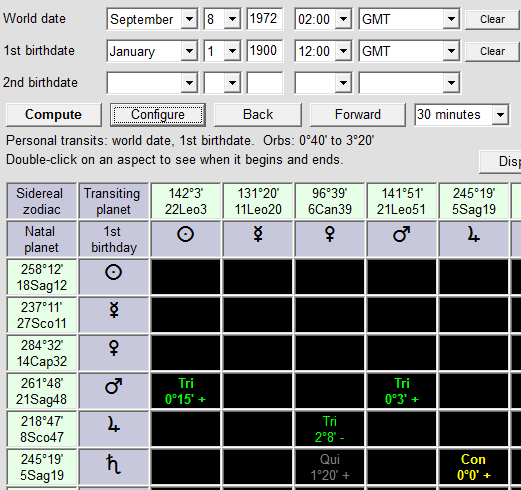 |
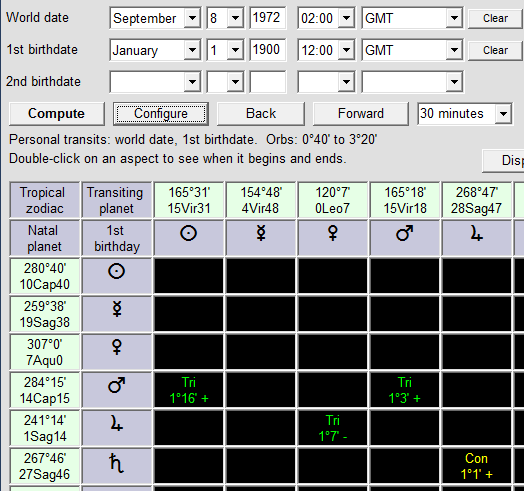 |
If we hold that for a transiting planet to be exactly conjunct to a natal planet it is necessary for the transiting planet to occupy exactly the same position relative to the fixed stars as the natal planet did at the time of birth, then for calculating personal transits the sidereal zodiac is preferable.
Personal transits occur earlier with the tropical zodiac than with the sidereal zodiac, and the difference increases with a person's age.
Consider, for example, a person born at 09:00 GMT on March 4, 1900. Their Venus was at 0° 2' Aries in the sidereal zodiac and at 22° 30' Aries in the tropical zodiac (the ayanamsha in 1900 being approximately 22° 28'). At 05:00 GMT on October 18, 1973, Uranus was at 0° 2' Libra in the sidereal zodiac, and so was exactly opposite to their natal Venus, as shown in the screenshot below from the Planetary Aspects and Transits software:
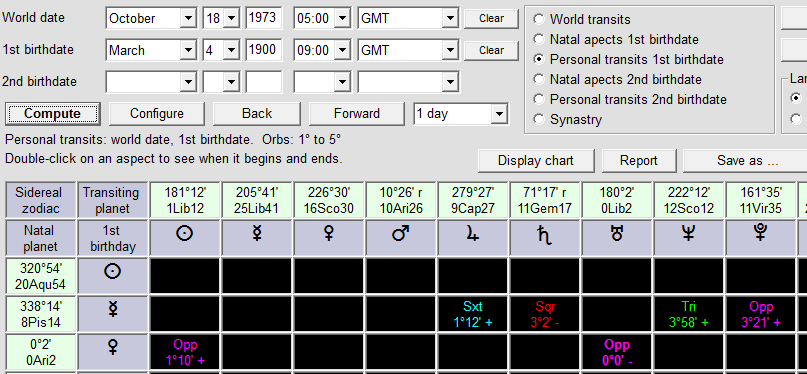
But with the tropical zodiac, transiting Uranus became exactly opposite to natal Venus at 22:00 GMT on October 1, 1973.
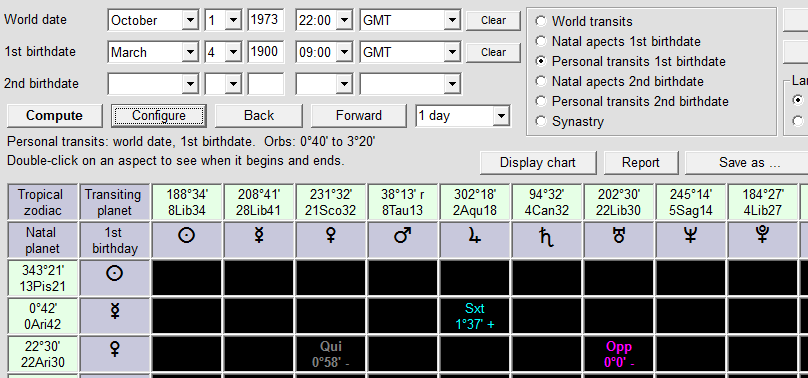
Thus transiting Uranus reached exact opposition to natal Venus about 17 days earlier with the tropical zodiac than with the sidereal zodiac. This is shown graphically in the image below. The mauve line shows the difference from exact opposition of transiting Uranus to natal Venus in the tropical zodiac, and the gray line shows the same in the sidereal zodiac.
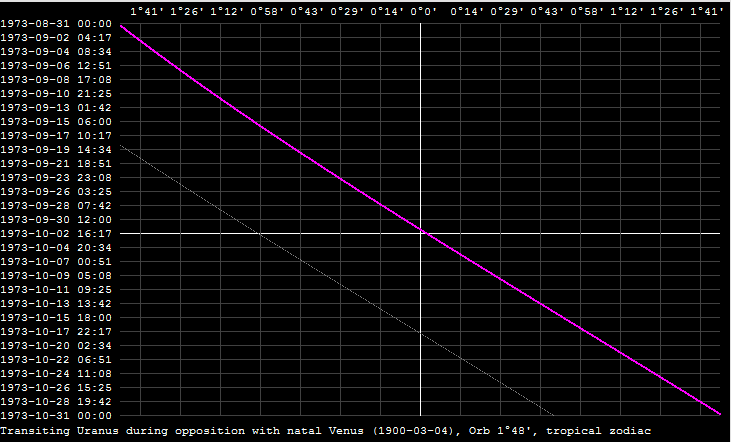
This can be explained as follows: In 73 years the direction which is called zero degrees Aries in the tropical zodiac moves backwards by 1° relative to the constellations. Thus in 1973 Uranus had a "head start" of 1° when travelling along the ecliptic to reach the position of 22° 30' Libra in the tropical zodiac (exactly opposite natal Venus), and so arrived earlier.
To illustrate the fact that the time difference between exact transits in the two zodiacs increases with a person's age consider again the person born at 09:00 GMT on March 4, 1900. Transiting Uranus reaches an exact square to natal Venus at 06:00 GMT on November 25, 1910, with the tropical zodiac, and with the sidereal zodiac reaches an exact square at 11:00 GMT on November 28, 1910, so the exact aspect occurs just 3 days earlier with the tropical zodiac rather than 17 days as in the case of the 1973 opposition considered above.
A similar phenomenon, of course, occurs with transiting planets other than Uranus. Since the inner planets move more quickly along the ecliptic than do the outer planets, we would expect that the time difference for the two zodiacs would be less for them since they take less time to traverse their "head start". Computation confirms this. Consider again the person born at 09:00 GMT on March 4, 1900. Transiting Mars reaches an exact trine to natal Neptune at 21:00 GMT on October 25, 1971, with the tropical zodiac, and with the sidereal zodiac reaches an exact trine at 23:00 GMT on October 27, 1971, so the exact aspect occurs 2 days earlier with the tropical zodiac rather than 17 days as in the case of the 1973 opposition considered above.
Thus we may sum this up by saying that, when using the tropical zodiac, personal transits occur earlier than when using the sidereal zodiac, by up to two weeks or more, and that, for any given transit, the difference for the two zodiacs is larger for the outer planets and increases with a person's age. Thus when calculating personal transits the choice of zodiac does make a significant difference.
| Planetary Aspects and Transits software | Your Planetary Transits software |